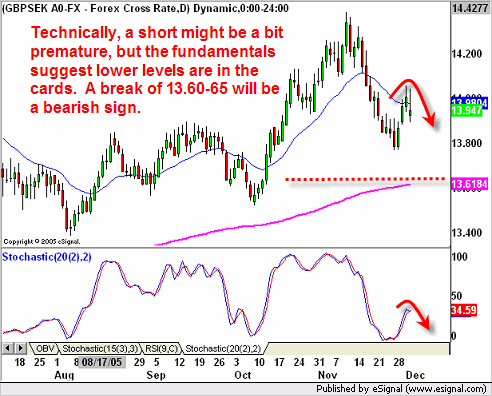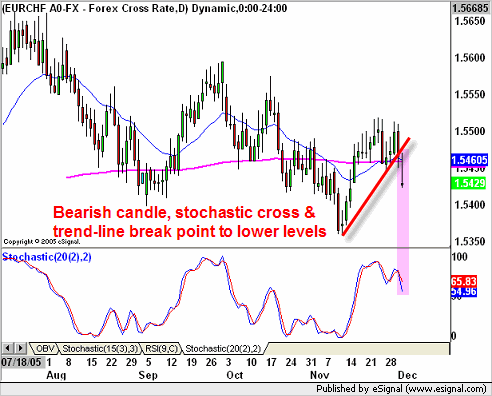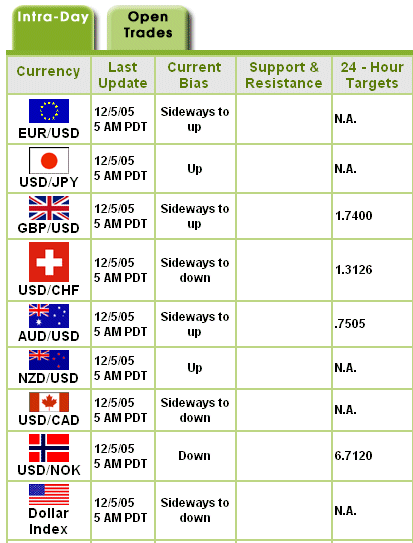I’m watching this as a longer-term short
Dave Floyd is a professional FX and stock trader
based in Bend, OR and the President of Aspen Trading Group. Dave’s approach to
FX combines technical and fundamental analysis that results in trades that fall
into the swing trading time frame of several hours to several days. To learn
more about how Dave trades,
click here.
While we realize that most FX
brokerages do not offer this cross (GBP/SEK), some of our
clients/readers do have access to this cross. We are keeping a close eye on this
one as a longer-term short.
Fundamental Reasons:
– Interest rate differentials between Sweden and the UK will begin to contract
as the Swedish Central Bank (Riksbank) will begin to tighten interest rates
aggressively in the coming months.
– Sweden enjoys a large current account surplus; while the UK runs a current
account deficit
Ideally we will wait for a break of 13.60-65 before initiating a short position,
however, we will begin to build our position on Monday and add to it when the
technical backdrop deteriorates further.
The short from a few weeks ago in EUR/CHF is beginning
to play out and for those that may have missed the entry, the current technical
backdrop still seems favorable.

Â

.Monday’s 24-Hour FX Targets

Â
Notes/How To for The 24-Hour FX Targets
Today’s FX traders are now demanding a more systematic
approach, and this new feature will nail those desires right on the head. With
our 24-hour forecasts you have specific entry prices, stop-loss and price
targets.Â
Entries:Â entry prices are meant
to be taken at the time of posting by simply placing an order to buy or sell at
the market. Targets will typically be posted by 5 AM PDT.
Stop-Loss:Â we suggest that all
traders place a stop-loss equivalent to ½ of the value of the projected gain in
pips. For instance, if the price target for the EUR/USD is 1.2200, and it is
trading at 1.2100 at the time (100 pip gain) of the forecast, we would suggest
setting a 50 pip stop loss (1.2050).Â
We also discuss a basic trailing stop strategy at the end of
this article.
Exits:Â traders should take
profits when the ‘Target Price’ is achieved.  If, by 5 AM PDT the following day,
the stop-loss or target price has not been achieved, simply close the trade at
market.
Let’s look at an few example as a way to illustrate how this
will work. Below is a screenshot from Thursday October 20th, it is exactly the
same format that will be posted here each Monday and Wednesday.
The far right column, 24-Hour Targets, is simply our estimate
of where the pair will trade towards during the next 24-hours. A ‘N.A’.
simply indicates we do not have a price target.
The ‘Current Bias’ column will only show a bias for the
pairs that are highlighted ‘blue’ as these are pairs that we also recommend on a
discretionary basis.
At 5 AM on 10/20/05 GBP/USD opened at 1.7665. The
price target, as noted above, is 1.7735 – a 70 pip gain if achieved. The
initial stop-loss would be 35 pips, or 1.7630.Â
GBP/USD went on to achieve both targets.
Naturally, not all of the forecasts will play out, and like
most systematic approaches, the number of iterations will increase your
success. Pairs like USD/JPY and EUR/USD did not achieve their
targets and were stopped out, resulting in a loss of 65 pips, while AUD/USD,
USD/CAD and USD/NOK easily offset the 65 pip loss with solid
gains.
Trailing Stops:
Traders may also look to employ a trailing stop strategy to
protect gains. We suggest using a trailing stop equivalent to 1/4 the value of
the targeted gains. So, in the example of the GBP/USD above, the target is for
a gain of 70 pips, therefore a trailing stop of 17 pips might be a prudent
approach.
Ultimately the decision is yours. Other traders/clients
simply use our forecast(s) as a guide and then identify their own entry points
based on their trading methodology.
As always, feel free to send me your comments and questions.
